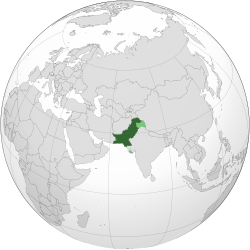
Back باكستان وأسلحة الدمار الشامل Arabic Armas de destrucción masiva en Pakistán Spanish Pakistanin joukkotuhoaseet Finnish Arsenal nucléaire du Pakistan French תוכנית הגרעין של פקיסטן HE Pakistan dan senjata pemusnah massal ID Broń jądrowa Pakistanu Polish پاکستان تے وڈے پیمانے اُتے تباہی پھیلانے والے ہتھیار PNB پاکستان او د ډله ييزو وژنو وسلې Pashto/Pushto Paquistão e as armas de destruição em massa Portuguese
| Islamic Republic of Pakistan | |
|---|---|
 | |
| Nuclear program start date | 20 January 1972 |
| First nuclear weapon test | 28 May 1998 (Chagai-I)[1] |
| Last nuclear test | 30 May 1998 (Chagai-II) |
| Largest yield test | 40 kt (PAEC claim)[2][3][4][5] |
| Total tests | 6 detonations[1] |
| Peak stockpile | 170 warheads (2025 estimate)[6] |
| Current stockpile | 170 warheads (2025 estimate)[7] |
| Maximum missile range | 2750 km (Shaheen-III)[8] |
| NPT party | No |
This article may need to be rewritten to comply with Wikipedia's quality standards, as Same content covered in multiple instances under different sections, article needs to be concise and specific to the topic of interest. (June 2025) |
| Nuclear weapons |
|---|
 |
| Background |
| Nuclear-armed states |
|
Pakistan is one of nine states that possess nuclear weapons. Pakistan is not party to the nuclear Non-Proliferation Treaty. As of 2025, multiple unofficial sources indicate a stockpile of 170 warheads (fission type).[9] [10] Pakistan maintains a doctrine of minimum credible deterrence instead of a no first-use policy, promising to use "any weapon in its arsenal" to protect its interests in case of an aggressive attack.[11]
Pakistan is not widely suspected of either producing biological weapons or having an offensive biological programme. Pakistan has ratified the Geneva Protocol, the Chemical Weapons Convention, as well as the Biological and Toxin Weapons Convention.[12][13]
- ^ a b "Pakistan Nuclear Weapons – A Chronology". Federation of American Scientists (FAS). FAS (Pakistan Nuclear Weapons – A Chronology). Archived from the original on 2012-04-27. Retrieved 2012-05-05.
- ^ Cite error: The named reference
faswas invoked but never defined (see the help page). - ^ Sublette, Carey (10 September 2001). "1998 Year of Testing". Nuclear Weapon Archives. Archived from the original on 2013-01-01. Retrieved 2013-01-12.
- ^ Approximating and calculating the exact, accurate and precise yields are difficult to calculate. Even under very controlled conditions, precise yields can be very hard to determine, and for less controlled conditions the margins of error can be quite large. There are number of different ways that the yields can be determined, including calculations based on blast size, blast brightness, seismographic data, and the strength of the shock wave. The Pakistan Government authorities puts up the yield range from 20-~40kt (as noted by Carey Sublette of the Nuclear Weapon Archives in her report. The explosion measured 5.54 degrees on the Richter magnitude scale, the PAEC provided the data as public domain in the KNET sources.
- ^ "Pakistan Nuclear Weapons: A Brief History of Pakistan's Nuclear Program". Federation of American Scientists. 11 December 2002. Retrieved 2019-10-30.
- ^ "Nuclear Notebook: Pakistan nuclear weapons, 2023".
- ^ "Nuclear Notebook: Pakistan nuclear weapons, 2023".
- ^ "Test launch of Pakistan's 'Shaheen-III' surface-to-surface ballistic missile successful". mid-day. 9 March 2015. Archived from the original on 2016-03-04. Retrieved 2016-04-26.
- ^ "Pakistan nuclear weapons, 2023". Bulletin of the Atomic Scientists. Retrieved 2025-06-08.
- ^ "Status of World Nuclear Forces". Federation of American Scientists. Retrieved 2025-06-08.
- ^ "Pakistan's Evolving Nuclear Doctrine | Arms Control Association". www.armscontrol.org. Archived from the original on 2025-06-04. Retrieved 2025-06-08.
- ^ Cite error: The named reference
NTI Research on Countrieswas invoked but never defined (see the help page). - ^ Cite error: The named reference
NTI Research on Countries with Chemical facilities and capabilities.was invoked but never defined (see the help page).
© MMXXIII Rich X Search. We shall prevail. All rights reserved. Rich X Search
